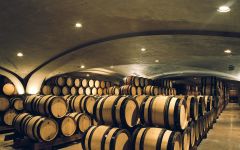Guigal Cotes du Rhone Rouge 2016
-
Wine &
Spirits -
Robert
Parker -
James
Suckling -
Jeb
Dunnuck



Product Details
Your Rating
Somm Note
Winemaker Notes
Deep dark red and shiny dress. Nose of black fruits marked by notes of spices. Full- bodied wine, full and racy. Tannins rounded, very coated but present in the mouth. This wine is distinguished by its size, heat and aromatic intensity.Complete wine, good persistence. Elegance and finesse due to a nice balance between tannins and fruits.
Blend: 50% Syrah, 40% Grenache, 10% Mourvèdre
Professional Ratings
-
Wine & Spirits
This contrasts sweet, juicy plum fruit and firm, spicy tannins with some earthy notes and bright cranberry highlights. Philippe Guigal bases this blend on syrah with grenache and mourvèdre, sourced from his network of 80-some growers and mellowed in barrels for 18 months before release. It’s an impressively structured and complex Côtes du Rhône red. Best Buy
-
Robert Parker's Wine Advocate
There are an impressive 4.5 million bottles of the 2016 Cotes du Rhone, a ripe, silky wine that should bring pleasure to thousands of consumers. Cherries and raspberries mark the nose, while the medium to full-bodied palate adds nuances of cola, tree bark and spice. Often available at retail for under $15 per bottle, it represents a terrific value.
-
James Suckling
Very brambly, rich and attractive tobacco, red and dark fruit and wild herbs. The palate has richness and an attractive feel with great core flesh and balance. The combination of quality, good value and accessibility here make this quite unique. Drink now.
-
Jeb Dunnuck
As with the white, the quality of the basic Côtes du Rhône is more than noteworthy, especially when you consider the quantity produced. From a great, great vintage for the Southern Rhône, the 2016 Côtes du Rhône shows an upfront, sunny style as well as Provençal notes of spiced red and black fruits, ground pepper, and garrigue. Drink this medium to full-bodied, ripe, sexy effort over the coming 4-6 years. It will evolve even longer, if you’re so inclined.
Other Vintages
2020- Decanter
-
Jeb
Dunnuck - Decanter
-
Robert
Parker -
Jeb
Dunnuck
-
Jeb
Dunnuck -
Robert
Parker -
Wine
Enthusiast
-
Wine &
Spirits -
Robert
Parker -
Jeb
Dunnuck -
Wine
Enthusiast
-
Robert
Parker
-
Robert
Parker
-
Wine
Enthusiast
-
Robert
Parker
-
Robert
Parker
-
Robert
Parker -
Wine &
Spirits
-
Robert
Parker
-
Wine
Spectator -
Robert
Parker
-
Wine
Enthusiast -
Robert
Parker







The Guigal domain was founded in 1946 by Etienne Guigal in the ancient village of Ampuis, home of the wines of the Côte-Rôtie. In these vineyards that are over 2400 years old, you can still see the small terraced walls characteristic of the Roman period. Etienne Guigal arrived in this region in 1923 at the age of 14. He made wine for over 67 vintages and, at the beginning of his career, participated in the development of the Vidal-Fleury establishment.
Despite his young age, Marcel Guigal took over from his father in 1961 when the latter was victim to a brutal illness rendering him blind. Marcel's hard work and perseverance enabled the Guigals to buy out Vidal-Fleury in 1984, although the establishment retains its own identity and commercial autonomy. In 2000, the Guigals purchased the Jean-Louis Grippat estate in Saint-Joseph and Hermitage, as well as the Domaine de Vallouit in Côte-Rôtie, Hermitage, Saint-Joseph and Crozes-Hermitage.
In the cellars of the Guigal estate in Ampuis, the northern appellations of the Rhône Valley are produced and aged. These are the appellations of Côte-Rôtie, Condrieu, Hermitage, Saint-Joseph and Crozes-Hermitage. The great appellations of the Southern Rhône, Chateauneuf-du-Pape, Gigondas, Tavel and Côtes-du-Rhône, are also aged in the Ampuis cellars.

With bold fruit flavors and accents of sweet spice, Grenache, Syrah and Mourvèdre form the base of the classic Rhône Red Blend, while Carignan, Cinsault and Counoise often come in to play. Though they originated from France’s southern Rhône Valley, with some creative interpretation, Rhône blends have also become popular in other countries. Somm Secret—Putting their own local spin on the Rhône Red Blend, those from Priorat often include Merlot and Cabernet Sauvignon. In California, it is not uncommon to see Petite Sirah make an appearance.

Typically thought of as a baby Chateâuneuf-du-Pape, the term Côtes du Rhône actually doesn’t merely apply to the flatter outskirts of the major southern Rhône appellations, it also includes the fringes of well-respected northern Rhône appellations. White wines can be produced under the appellation name, but very little is actually made.
The region offers some of the best values in France and even some first-rate and age-worthy reds. Red wine varieties include most of the Chateâuneuf-du-Pape varieties like Grenache, Syrah, Mourvedre, Cinsault, and Counoise, as well as Carignan. White grapes grown include Grenache blanc, Roussanne and Viognier, among others.
